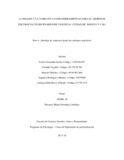Please use this identifier to cite or link to this item:
https://repository.unad.edu.co/handle/10596/22775Full metadata record
| DC Field | Value | Language |
|---|---|---|
| dc.contributor.advisor | Caballero Lozada, Maria Fernanda | - |
| dc.coverage.spatial | cead_-_josé_acevedo_y_gómez | spa |
| dc.creator | Russi Villamil, Adriana Edith, Guzmán García, Yurivia, Trujillo, Yeraldin, Ordoñez, Marisol, Rodríguez Medina, Angélica | - |
| dc.date.accessioned | 2018-12-13T22:51:59Z | - |
| dc.date.available | 2018-12-13T22:51:59Z | - |
| dc.date.created | 2018-11-28 | - |
| dc.identifier.uri | https://repository.unad.edu.co/handle/10596/22775 | - |
| dc.description | La Imagen y la Narrativa como herramientas para el abordaje psicosocial en escenarios de violencia ciudad de Bogotá y Cali. | spa |
| dc.description.abstract | El mayor propósito de este trabajo desde los enfoques narrativos y desde las líneas del fenómeno de la violencia, es resaltar la importancia del y de los profesionales en las áreas humanísticas para abordar los escenarios comunitarios desde las acciones psicosociales; dadas como aquellas que acatan el cumplimiento de los derechos humanos en todo su esplendor y que actúan bajo la premisa de recuperar al individuo, su familia y sus contextos emergentes. Es por tanto que desde esa primera óptica de atención se debe brindarle al ciudadano afectado los cuidados básicos que permitan hacerles merecedores de todos los derechos que se han diseñado para brindarles atención a fin de reparar el daño causado, hacerles garantes de la búsqueda de la verdad, los procesos de reconciliación y las acciones de justicia a favor de las víctimas. La identificación de esas necesidades especiales puede ayudar a los profesionales a diseñar herramientas que desde la dimensión subjetiva del actor implicado puedan abordarse identificando esos recursos y potencialidades personales para empoderarlos en pro de su propio bienestar. Una de las prioridades de la Atención Psicosocial deberá corresponder a esa capacidad de los profesionales desde el trabajo interdisciplinario por co-construir de manera empalmada con la víctima o las víctimas, acciones psicoeducativas; aquellas que les permitan continuar trabajando sobre sus proyectos de vida personales y poder reconocerse como sobrevivientes. Por consiguiente desde el estudio de caso de las Comunidades de la Cacarica se propone brindar nuevas direccionalidades a los abordajes de intervención en donde las acciones psicosociales puedan humanizarse y ampliarse desde el propio sentir del y de los individuos. | spa |
| dc.format | spa | |
| dc.format.mimetype | application/pdf | spa |
| dc.language.iso | spa | spa |
| dc.publisher | Universidad Nacional Abierta y a Distancia UNAD | spa |
| dc.title | La Imagen y la Narrativa como herramientas para el abordaje psicosocial en escenarios de violencia ciudad de Bogotá y Cali | spa |
| dc.type | Diplomado de profundización para grado | spa |
| dc.subject.keywords | Comunidad Cacarica, Derechos Humanos, Estrategias de Intervención | spa |
| dc.description.abstractenglish | The main purpose of this work from the narrative approaches and from the lines of the phenomenon of violence, is to highlight the importance of the professionals in the humanistic areas to approach the community scenarios from the psychosocial actions; given as those that comply with the fulfillment of human rights in all their splendor and that act under the premise of recovering the individual, their family and their emerging contexts. It is therefore that from that first perspective of attention should be given to the affected citizen the basic care that allows them to deserve all the rights that have been designed to provide care in order to repair the damage caused, make them guarantors of the search for the truth , the processes of reconciliation and the actions of justice in favor of the victims. The identification of these special needs can help professionals to design tools that can be approached from the subjective dimension of the actor involved, identifying those resources and personal potentialities to empower them for their own welfare. One of the priorities of the Psychosocial Attention must correspond to that capacity of the professionals from the interdisciplinary work to co-construct in a spliced way with the victim or the victims, psychoeducational actions; those that allow them to continue working on their personal life projects and be able to recognize themselves as survivors. Therefore, from the case study of the Communities of the Cacarica, it is proposed to offer new directions to the intervention approaches in which the psychosocial actions can be humanized and extended from the own senses of the individuals. What is expected after the intervention processes at a professional level is to guarantee the subjects psychoeducational guidelines that will facilitate them to work from their own experience without the same being to remain as a victim. It is important that psychosocial care of the first instance is not reduced to the immediate moment; it must be extended to this second stage of attention, with the purpose of reducing psychoemotional affectations and being able to work from the professional in favor of the mental health of human beings. | spa |
| dc.subject.category | Humanísticas | spa |
| dc.rights.accesRights | info:eu-repo/semantics/openAccess | spa |
| dc.rights.acceso | Abierto (Texto Completo) | spa |
| Appears in Collections: | Diplomado Acompañamiento Psicosocial en Escenarios de Violencia | |
Files in This Item:
| File | Description | Size | Format | |
|---|---|---|---|---|
| aerussiv.pdf | La Imagen y la Narrativa como herramientas para el abordaje psicosocial en escenarios de violencia ciudad de Bogotá y Cali. | 303.68 kB | Adobe PDF |  View/Open |
Items in DSpace are protected by copyright, with all rights reserved, unless otherwise indicated.
